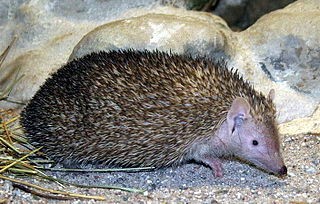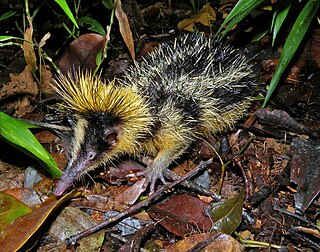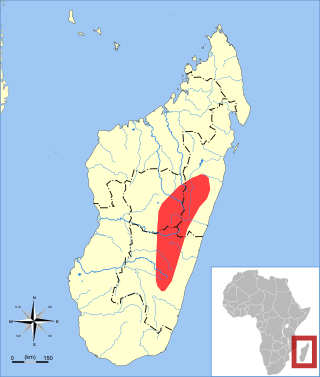
The clade Tenrecoidea or Afrosoricida contains the golden moles of Southern Africa, the otter shrews of equatorial Africa and the tenrecs of Madagascar. These three groups of small mammals were for most of the 19th and 20th centuries regarded as a part of the Insectivora or Lipotyphla. Both groups, as traditionally used, are polyphyletic.

Tenrecomorpha is the suborder of otter shrews and tenrecs, a group of afrotherian mammals indigenous to equatorial Africa and Madagascar, respectively. The two families are thought to have split about 47–53 million years ago. Potamogalid otter shrews were formerly considered a subfamily of Tenrecidae. The suborder is also presumed to contain the extinct genus Plesiorycteropus, a group of possibly fossorial insectivores similar to aardvarks, which is known to be more closely related to tenrecs of subfamily Tenrecinae than to golden moles of suborder Chrysochloridea.

A tenrec is any species of mammal within the afrotherian family Tenrecidae, which is endemic to Madagascar. Tenrecs are a very diverse group; as a result of convergent evolution some resemble hedgehogs, shrews, opossums, rats, and mice. They occupy aquatic, arboreal, terrestrial, and fossorial environments. Some of these species including the greater hedgehog tenrec, can be found in the Madagascar dry deciduous forests. However, the speciation rate in this group has been higher in humid forests.

The giant otter shrew is a semiaquatic, carnivorous afrotherian mammal. It is found in the main rainforest block of central Africa from Nigeria to Zambia, with a few isolated populations in Kenya and Uganda. It lives in streams, wetlands and slow flowing larger rivers. It is the only species in the genus Potamogale. Otter shrews are most closely related to the tenrecs of Madagascar.

The web-footed tenrec, Malagasy otter shrew, or aquatic tenrec is the only known semiaquatic tenrec, and is found in eastern Madagascar, especially in and around Ranomafana National Park. It grows to between 25 and 39 cm, and was once thought to be extinct. It feeds on crabs, aquatic insects, and crayfish. The population is considered vulnerable. It was formerly placed in the monotypic genus Limnogale, but has been moved to Microgale based on molecular data showing it to be deeply nested within the latter.

The Nimba otter shrew is a dwarf otter shrew and belongs to the mammal family Potamogalidae. Otter shrews are shrew-like afrotherian mammals found in sub-Saharan Africa. They are most closely related to the tenrecs of Madagascar. This species belongs to the genus Micropotamogale, literally meaning "tiny river weasel". It is native to the Mount Nimba area which rests along the border of Liberia, Guinea, and Côte d’Ivoire in West Africa.
Microgale is a genus of mammal in the family Tenrecidae. There are 21 living species on the island of Madagascar and one extinct species known from a fossil. Some species have been discovered in the last twenty years.

Cowan's shrew tenrec is a species of mammal in the family Tenrecidae.

Dobson's shrew tenrec is a species of mammal in the family Tenrecidae. It is endemic to Madagascar. Its natural habitats are subtropical or tropical moist forests, plantations, and heavily degraded former forest. On the basis of molecular data indicating that it and Talazac's shrew tenrec form a sister group to the rest of Microgale, these two species were transferred from Microgale to Nesogale in 2016.

The dryad shrew tenrec, also known as the tree shrew tenrec, is a species of mammal in the family Tenrecidae. It is endemic to Madagascar. Its natural habitat is subtropical or tropical moist lowland forests.

The pale shrew tenrec, also known as the pale-footed shrew tenrec is a species of mammal in the family Tenrecidae. It is endemic to Madagascar. Its natural habitats are subtropical and tropical moist lowland and montane forests.

The pygmy shrew tenrec is a species of placental mammal in the family Tenrecidae. It is endemic to Madagascar. Its natural habitat is subtropical or tropical moist forests. While it is not endangered, its population is slowly declining as it is threatened by habitat loss. This is of concern, though does not yet merit a higher protection level.

The greater long-tailed shrew tenrec is a species of mammal in the family Tenrecidae. It is endemic to Madagascar, where its natural habitats are subtropical or tropical moist forests.

Talazac's shrew tenrec is a species of mammal in the family Tenrecidae. It is endemic to Madagascar. Its natural habitats are subtropical or tropical moist forests. On the basis of molecular data indicating that it and Dobson's shrew tenrec form a sister group to the rest of Microgale, these two species were transferred from Microgale to Nesogale in 2016.

The Ruwenzori otter shrew is a species of semiaquatic dwarf otter shrew of the family Potamogalidae. It is found in the Democratic Republic of the Congo, Rwanda, and Uganda. Otter shrews are shrew-like afrotherian mammals found in sub-Saharan Africa. They are most closely related to the tenrecs of Madagascar.

Potamogalidae is the family of "otter shrews", a group of semiaquatic riverine afrotherian mammals indigenous to sub-Saharan Africa. They are most closely related to the tenrecs of Madagascar, from which they are thought to have split about 47–53 million years ago. They were formerly considered a subfamily of Tenrecidae.
Oryzorictinae is a subfamily of tenrecs endemic to the island of Madagascar. It is the largest of three tenrec subfamilies. Oryzorictinae is thought to have split from the lineage of its closest relative, Geogale, about 30 million years (Ma) ago. The deepest phylogenetic split within the subfamily, that between Oryzorictes and a clade composed of Microgale plus Nesogale, is thought to have occurred about 28 Ma ago. In turn, Microgale and Nesogale are thought to have diverged about 19 Ma ago.













